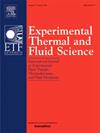Impingement of droplets with various liquid viscosities on a low-speed rotational surface
IF 2.8
2区 工程技术
Q2 ENGINEERING, MECHANICAL
Experimental Thermal and Fluid Science
Pub Date : 2025-01-30
DOI:10.1016/j.expthermflusci.2025.111426
引用次数: 0
Abstract
The dynamic behavior of droplets with different liquid viscosities impacting a low-speed rotational surface was experimentally investigated. The effects of rotation and viscosity on the droplet morphology and spreading behavior were analyzed. The experimental results show that five typical morphologies-cap, splitting, deposition, secondary droplets, and lobes-exist in the droplet spreading on a rotational surface. The Rossby number and Ohnesorge number have important effects on the droplet morphologies. At a high Rossby number (Ro > 4), the droplet exhibits a cap shape at the end of the retraction stage because the inertial force plays a dominant role. At a low Rossby number (Ro < 2), the droplet exhibits splitting or deposition on the rotational surface. Secondary droplets may appear under certain conditions for the droplets with medium or high viscosity owing to the interaction among the tangential force, viscous force, and surface tension. At a medium Rossby number, the droplet is mainly deposited or cap-shaped in the end. The phenomenon of lobes is independent of the Rossby number, but is related to the Ohnesorge number. The lobes appear only at a medium or low Ohnesorge number during droplet spreading and retraction. In addition, the spreading behavior of a droplet impacting a rotational surface can be divided into retraction mode, oscillatory equilibrium mode, and continuous spreading mode. Empirical models were proposed for the maximum circumferential wetting length and the maximum wetting time. For the retraction mode, the empirical models produce mean relative errors of 5.08 % and 7.76 % for the maximum circumferential wetting length and the maximum wetting time, respectively. For the oscillatory equilibrium mode, the empirical models produce mean relative errors of 4.79 % and 9.98 % for the maximum circumferential wetting length and the maximum wetting time, respectively. The agreement between the predicted and experimental results is improved significantly when both rotation and viscosity effects are considered.
具有不同液体粘度的液滴在低速旋转表面上的碰撞
实验研究了不同粘度液滴撞击低速旋转表面的动力学行为。分析了旋转和粘度对液滴形貌和扩散行为的影响。实验结果表明,液滴在旋转表面上扩散时存在帽状、劈裂状、沉积状、二次液滴状和叶状五种典型形态。罗斯比数和奥内乔治数对液滴形态有重要影响。在高罗斯比数(Ro >;4)由于惯性力起主导作用,液滴在缩回阶段结束时呈帽状。在低罗斯比数(Ro <;2)液滴在旋转表面出现分裂或沉积。由于切向力、粘滞力和表面张力的相互作用,中等或高粘度的液滴在一定条件下会出现二次液滴。中等罗斯比数时,液滴最终以沉积状或帽状为主。叶现象与罗斯比数无关,但与奥内乔治数有关。在液滴扩散和收缩过程中,裂片只出现在中等或较低的奥涅斯格数。此外,液滴撞击旋转表面的扩散行为可分为缩回模式、振荡平衡模式和连续扩散模式。提出了最大周向润湿长度和最大润湿时间的经验模型。对于缩回模式,经验模型对最大周向润湿长度和最大润湿时间的平均相对误差分别为5.08%和7.76%。对于振荡平衡模式,经验模型对最大周向润湿长度和最大润湿时间的平均相对误差分别为4.79%和9.98%。当同时考虑旋转和黏度效应时,预测结果与实验结果的一致性显著提高。
本文章由计算机程序翻译,如有差异,请以英文原文为准。
求助全文
约1分钟内获得全文
求助全文
来源期刊

Experimental Thermal and Fluid Science
工程技术-工程:机械
CiteScore
6.70
自引率
3.10%
发文量
159
审稿时长
34 days
期刊介绍:
Experimental Thermal and Fluid Science provides a forum for research emphasizing experimental work that enhances fundamental understanding of heat transfer, thermodynamics, and fluid mechanics. In addition to the principal areas of research, the journal covers research results in related fields, including combined heat and mass transfer, flows with phase transition, micro- and nano-scale systems, multiphase flow, combustion, radiative transfer, porous media, cryogenics, turbulence, and novel experimental techniques.
 求助内容:
求助内容: 应助结果提醒方式:
应助结果提醒方式:


